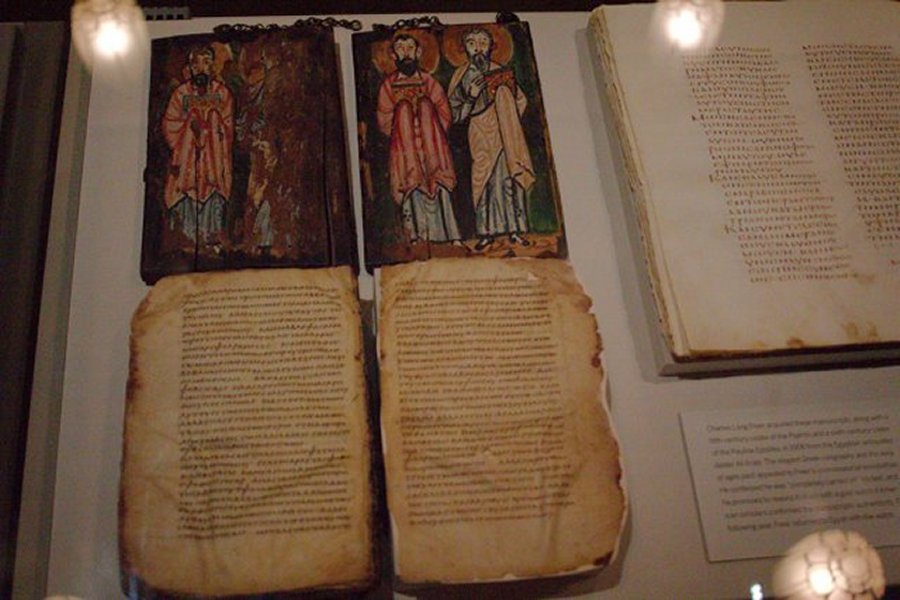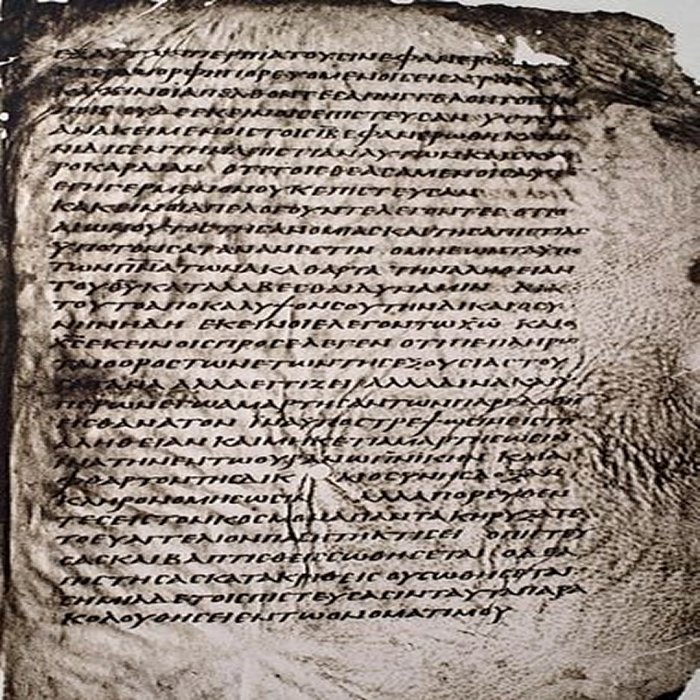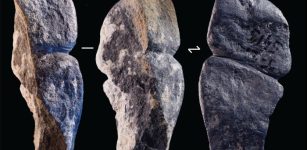Codex Washingtonianus Contains A Passage Not Seen In Any Other Biblical Manuscript
Ellen Lloyd - AncientPages.com - The Codex Washingtonianus is the world's third oldest Bible, and it is at the Smithsonian's Freer Gallery of Art.
 Codex Washingtonianus is the world’s third oldest Bible. Author: Two scribes. Language: Greek, 4th-5th century.
Codex Washingtonianus is the world’s third oldest Bible. Author: Two scribes. Language: Greek, 4th-5th century.
It comprises the four Gospels in the so-called Western order (Matthew, John, Luke, and Mark, as Dea).
It was acquired in Egypt by C.L. Freer, an American businessman and philanthropist (hence, the Freer-Gospels), in 1906 and is now in the Freer Gallery of Art of the Smithsonian Institution in Washington, D.C. Codex Washingtonianus is a 4th–5th-century manuscript probably copied from several different manuscripts.
This priceless ancient book is heavily guarded and rarely makes public appearances. The last time it was on display was in February 2014, when curators showed the document in the Freer Gallery's Victorian Peacock Room, along with a second of four ancient manuscripts purchased by Freer, the museum's founder. The two remaining manuscripts are too delicate or damaged and cannot be put on display.
The Bible has a painted wooden cover, with almost 200 parchment pages, and is reportedly over 1,500 years old.
It features the four Gospels in Greek and is known as the "Codex Washingtonianus," or the "Washington Gospels."
 Painted cover of the Codex Washingtonianus, depicting the evangelists Luke and Mark (7th century).
Painted cover of the Codex Washingtonianus, depicting the evangelists Luke and Mark (7th century).
The gallery said Freer purchased the manuscripts in 1906 in Giza, Egypt, and later organized and underwrote significant early biblical scholarship.
The pages are sensitive to light and humidity, so the codex never leaves the museum and isn't exhibited very often.
According to Craig Evans, a biblical scholar at Acadia University in Nova Scotia, only two other complete Gospels texts —Matthew, Mark, Luke, and John—are older than the Codex Washingtonians. They are the Codex Vaticanus, which is held at the Vatican, and the Codex Sinaiticus, which is usually held at the British Library in London.
When the Codex Washingtonianus was first published publicly in 1912, it caused controversy because it contained an extra passage in the Gospel of Mark.
 Mark 16:12-17 with the Freer Logion in 16:14. Image credit: Author unknown - Public Domain
Mark 16:12-17 with the Freer Logion in 16:14. Image credit: Author unknown - Public Domain
"While researching their cultural context and physical structure, it was discovered that the Washington Codex contains a passage not found in any other biblical text - a segment at the end of the Gospel of Mark known as the Freer logion (a logion is a saying attributed to Jesus)," the Free gallery said.
A translation of the Freer logion reads: "And Christ replied to them, 'The term of years of Satan's power has been fulfilled, but other terrible things draw near.'"
That passage seemed to address whether God or Satan was in charge, said Bethel University's Holmes.
Evans said that news of the passage at the time came amid rumblings that the King James Version wasn't sufficiently representative of the earliest iteration of the Bible. Conservative Christians were unhappy about that, he added.
So, the publication of the Codex Washingtonianus, with its additional passage attributed to Jesus, caused more consternation because it was another challenge to the Bible that people knew.
He said it's not so much a problem now, but it shook up many people at the time.
The additional passage, referred to as the Freer logion, was probably an oral saying that somehow made its way into the Gospels, said Holmes.
"There's no religious tradition that uses it as part of Scripture," he said. "It's almost like a margin comment that somebody wrote down because they heard it and wanted to remember it, and the scribe worked it in later."
He wasn't particularly religious or attracted to them as sacred texts. Freer purchased the codex partly because he found it mysterious and beautiful.
Written by - Ellen Lloyd – AncientPages.com
Updated on May 20, 2024
Copyright © AncientPages.com All rights reserved. This material may not be published, broadcast, rewritten or redistributed in whole or part without the express written permission of AncientPages.com
More From Ancient Pages
-
 Stone Artifacts Reveal Humans Lived In Philippines 700,000 Years Ago – Much Earlier Than Previously Thought
Archaeology | May 11, 2018
Stone Artifacts Reveal Humans Lived In Philippines 700,000 Years Ago – Much Earlier Than Previously Thought
Archaeology | May 11, 2018 -
 Extraordinary Discovery Of First Viking Tower In Viborg, Denmark Re-Writes Viking History
Archaeology | Jan 30, 2017
Extraordinary Discovery Of First Viking Tower In Viborg, Denmark Re-Writes Viking History
Archaeology | Jan 30, 2017 -
 Reconstructed Roman Gateway Tells The Story Of Britain’s Invasion
Featured Stories | Aug 26, 2023
Reconstructed Roman Gateway Tells The Story Of Britain’s Invasion
Featured Stories | Aug 26, 2023 -
 Ancient Hongshan Culture: Creators Of A Pyramid And Remarkable Artifacts That Are Still Shrouded In Mystery
Ancient Mysteries | Jun 20, 2015
Ancient Hongshan Culture: Creators Of A Pyramid And Remarkable Artifacts That Are Still Shrouded In Mystery
Ancient Mysteries | Jun 20, 2015 -
 Sailing With The Phoenicians: Great Traders, Sailors And Navigators
News | Sep 6, 2015
Sailing With The Phoenicians: Great Traders, Sailors And Navigators
News | Sep 6, 2015 -
 Melisandre, The Red Woman: The History Behind Game Of Thrones’ Mysterious Mystic
Featured Stories | Jun 19, 2019
Melisandre, The Red Woman: The History Behind Game Of Thrones’ Mysterious Mystic
Featured Stories | Jun 19, 2019 -
 Bayeux Tapestry: Original Location Of Remarkable Romanesque Art – Finally Solved
Archaeology | Oct 26, 2019
Bayeux Tapestry: Original Location Of Remarkable Romanesque Art – Finally Solved
Archaeology | Oct 26, 2019 -
 When Giants Ruled North America – Encounters With Mysterious Races Of Giants – Part 1
Ancient Mysteries | Nov 20, 2018
When Giants Ruled North America – Encounters With Mysterious Races Of Giants – Part 1
Ancient Mysteries | Nov 20, 2018 -
 Oldest Carving Of A Penis Discovered On Ancient Mongolian Pendant
Archaeology | Jun 20, 2023
Oldest Carving Of A Penis Discovered On Ancient Mongolian Pendant
Archaeology | Jun 20, 2023 -
 DNA Unravels Mysteries Of The Crannogs, Ancient Artificial Islands Older Than Stonehenge
Archaeology | Oct 10, 2022
DNA Unravels Mysteries Of The Crannogs, Ancient Artificial Islands Older Than Stonehenge
Archaeology | Oct 10, 2022 -
 The Untold Story Of The Lost City Of Machu Picchu Ignored By Historians
Ancient Mysteries | Aug 4, 2020
The Untold Story Of The Lost City Of Machu Picchu Ignored By Historians
Ancient Mysteries | Aug 4, 2020 -
 Why Did King Solomon Hide Advanced Technology In A Secret Place? – The Great Deception – Part 2
Ancient Mysteries | Apr 3, 2021
Why Did King Solomon Hide Advanced Technology In A Secret Place? – The Great Deception – Part 2
Ancient Mysteries | Apr 3, 2021 -
 Eclipse Was A Bad Omen, A Sign Of Gloom And Doom In Ancient Peoples’ Beliefs
Featured Stories | Sep 25, 2015
Eclipse Was A Bad Omen, A Sign Of Gloom And Doom In Ancient Peoples’ Beliefs
Featured Stories | Sep 25, 2015 -
 Secrets And Lies: Spies Of The Stuart Era Played A Dangerous Game In The Shadows Of An Unstable Europe
Featured Stories | Nov 11, 2024
Secrets And Lies: Spies Of The Stuart Era Played A Dangerous Game In The Shadows Of An Unstable Europe
Featured Stories | Nov 11, 2024 -
 Evidence Of Sangam Age Settlement Unearthed At Nangur, Tamil Nadu
Archaeology | Jul 11, 2019
Evidence Of Sangam Age Settlement Unearthed At Nangur, Tamil Nadu
Archaeology | Jul 11, 2019 -
 How Did Norman Conquest Of 1066 Affect Everyday People’s Eating Habits?
Archaeology | Jul 7, 2020
How Did Norman Conquest Of 1066 Affect Everyday People’s Eating Habits?
Archaeology | Jul 7, 2020 -
 On This Day In History: Army Of Tsar Alexander I Of Russia Enters Paris – On March 31, 1814
News | Mar 31, 2016
On This Day In History: Army Of Tsar Alexander I Of Russia Enters Paris – On March 31, 1814
News | Mar 31, 2016 -
 Neanderthals Were Morning People – A New Study Says
Biology | Dec 14, 2023
Neanderthals Were Morning People – A New Study Says
Biology | Dec 14, 2023 -
 On This Day In History: Albert Einstein Publishes His General Theory Of Relativity – On Mar 20, 1916
News | Mar 20, 2017
On This Day In History: Albert Einstein Publishes His General Theory Of Relativity – On Mar 20, 1916
News | Mar 20, 2017 -
 First Cemetery Dated To Roman Period Discovered In North Saqqara, Egypt
Archaeology | Nov 12, 2019
First Cemetery Dated To Roman Period Discovered In North Saqqara, Egypt
Archaeology | Nov 12, 2019
